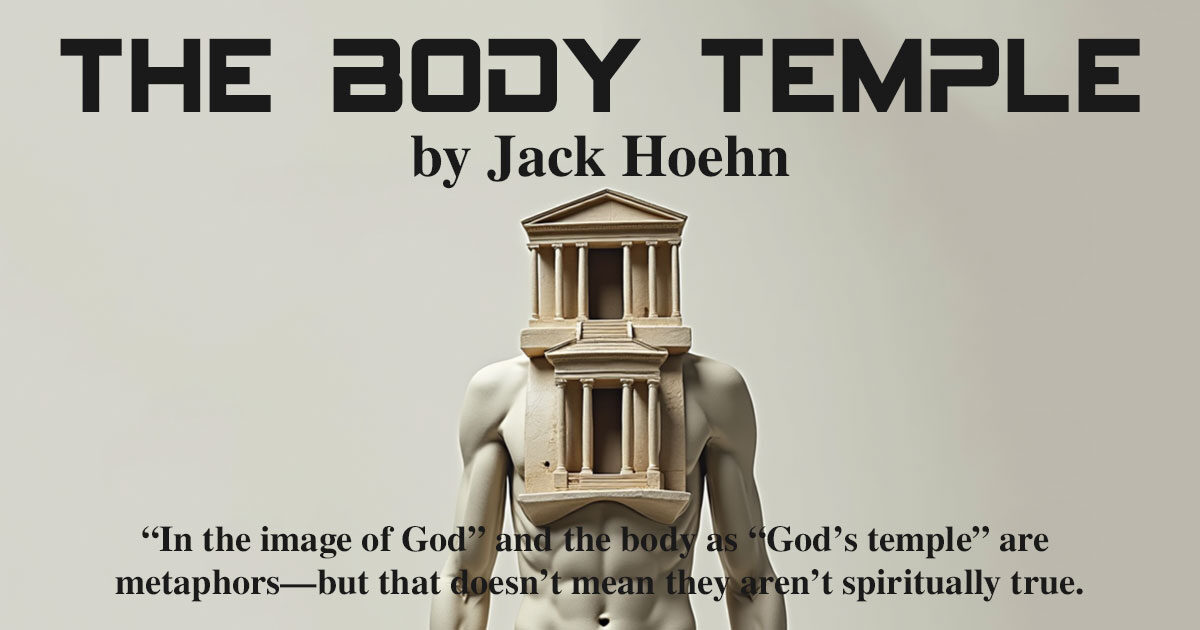What Does It Mean to Be God’s Temple, Made in His Image?
by Jack Hoehn | 28 May 2025 |

“Being made merely
in the image of God, but not otherwise
resembling him enough
to be mistaken for him by anybody
but a very near-sighted person.”
“I believe that our Heavenly Father
invented man because he was
disappointed in the monkey.”
—Mark Twain
Mark Twain is noted for monkeying around with words and ideas we often don’t think about, until we start laughing at them with his help. In this case, he helps to remind us that reading the Bible literally—holding the “plain meaning” of a metaphor—becomes laughable if taken literally.
To be specific: how can our physical body become a temple to a spiritual God? Is “God” just a word for all that is, or can there be a Creator separate from the physical realities we live in?
Literalism and physicality
Jesus the son of Mary was physical. He was God “in the flesh.” But God the Father and God the Holy Spirit are not (and before the first Christmas, neither was the Son) physical. Even though the Bible uses all these metaphors. Just because we have fingers does not mean that God the Father has fingers (Deut 9:10). That we have eyes does not mean that God the Holy Spirit has a retina (2 Chron 16:9). That we have ears does not mean that there is a giant divine tympanum stretched across Orion (Isa 37:17). The Bible uses these body metaphors to explain the invisible, not to make God physical.
That angels have wings (Isaiah 6:2) does not make them birds or airplanes. It means that like birds or jets they can move through space at will. But unlike birds, they are not carbon-based creatures. They are only visible to us at their will—perhaps like a hologram? God making humans “in our image” “after our likeness” is informative about us, not information about him. That our bodies can become God’s temple does not make us in any way God or even part of God.
“The body temple” is a metaphor, a material illustration of an immaterial reality.
God making humans “in our image” “after our likeness” is informative about us, not information about him.
A little girl I knew was given a child’s explanation of human conception as “Daddy put a little seed inside Mommy.” She then began consciously swallowing all her cherry pits instead of spitting them out, wanting to have a baby of her very own from the “little seed”!
Physicalizing metaphors never helps.
So with the Adventist speculation about the trinity. The anti-trinitarian subordination of Jesus to God the Father, and the minimization of the Holy Spirit, seems to me to be an immature argument over metaphors. Humans are subordinate to God. Jesus became human and accepted this subordination. But to deny his equality with the Father or the equality of the Holy Spirit with both seems to me a problem of physicalizing metaphors. Male fathers felt themselves superior to children and women and other races, etc., so physicalizing the metaphor of “Son,” they subordinated Jesus.
Our white male Adventist founders were anti-trinitarian but they grew out of it with the help of an inspired woman. They grew in understanding, they left “childish ways” of thinking, just as the little girl swallowing cherry seeds one day grew up and become a real mother without any help from cherries.
 Nineteenth-century Christianity in general, and 20th-century fundamentalism in particular, were physical belief systems. They were taught that the heavenly Books of Life were likely paper books or leather scrolls with clerical angels sitting at heavenly desks writing names using heavenly ink and sharpened goose (or angel feather?) quills. For early Adventists the heavenly sanctuary:
Nineteenth-century Christianity in general, and 20th-century fundamentalism in particular, were physical belief systems. They were taught that the heavenly Books of Life were likely paper books or leather scrolls with clerical angels sitting at heavenly desks writing names using heavenly ink and sharpened goose (or angel feather?) quills. For early Adventists the heavenly sanctuary:
“was a physical place in a specific location in the cosmos, a place where God the Father and his son, Jesus, material beings both, ruled over a court in heaven. There was nothing ‘spiritual’ or metaphorical about this: the material nature of heaven and its inhabitants were to be taken literally, and Jesus’ literal work in the innermost chamber of the heavenly temple [the Most Holy Place] would form the basis of what Seventh-day Adventists… call the sanctuary doctrine.”
—Brian C. Wilson, John Harvey Kellogg and the Religion of Biologic Living, Indiana University Press (2014), p. 23.
Telescopes, satellites, radio telescopes, and Hubble and James Webb satellite telescopes have removed our earth from the center, and exploded past the edges of infinity any visible human-sized “up-there” physical Heaven we imagined we were being shown. Seventeen-year-old Ellen Harmon’s visions of heaven and beings on other planets were visionary and spiritual experiences, not factual observations. I think we must understand them as metaphors.
The angels Ellen visioned are by definition not physical. We can’t see them unless they choose to display themselves. When we close our physical eyes and give permission for our minds we can dream or vision them with Ellen. But then we must call them dreams, not observations; hopes not facts; ideas not evidence. Prophecies are things that might happen, not things that must happen. “Visions” can clearly be of God, but a vision from God is still a vision, not a reality. Visions can be hopes, promises, comforts, fears, from the immaterial God. But his heaven is not part of this physical universe. Heaven is what was here before the universe, and will be after the universe.
“Visions” can clearly be of God but a vision from God is still a vision, not a reality.
Spiritual is real
So in what sense can our physical bodies be temples of God? Are we saying they are temples of nothing? No. Spiritual things are real even if they are not physical. Thoughts, ideas, conclusions, judgments, decisions, feelings, dreams, hope, plans, emotions, griefs, loves are all real. And because these immaterial things affect our physical health and what we use our physical body to do, there are materialists who claim they are all just chemical. They are “evolved illusions.” But if this is true, then that very thought and the conclusions just offered us by materialists cannot themselves be in any sense true. “Everything is just an illusion” must then be itself an illusion!
Spiritual, non-material, things cannot be weighed on a scale, but they can be recorded, discussed, shared, remembered, forgotten, rejected, or accepted. They are not material, but they are very real. And they can cause physical actions to happen, or stop physical actions from happening. Spiritual decisions affect physical health and physical wellbeing as well as mental and emotional health.
Proof of the self
The proof for me that the Self is real—that there is a real me and a real you, a soul beyond and more than the physical and mechanical and material of our bodies—is unselfishness. It is the willing, uncoerced self-sacrifice of a mother for her children, the hero for the stranger, the soldier for the nation, the stronger for the weak, the Messiah for the race that proves the existence of things above, beyond, unrestrained by physicality. In the previous article I quoted the poem “Invictus” by William Henley that Nelson Mandela used to support his spirit during decades of imprisonment.
The reality of the “I,” the self, the person or soul inside these mortal bodies is what offers courage and hope in situations otherwise hopeless, as demonstrated in the lives of both Nelson Mandela and by poet Henley himself. From 12 years of age William Henley, living in Edinburgh, had tuberculosis of the bone that took his left leg after multiple painful surgical drainages and then later his right foot. He spent months and years in hospitals with the then-incurable disease. Henley’s friend Robert Lewis Stevenson said he styled his famous pirate Long John Silver in “Treasure Island” after William stumping about on his wooden leg! In spite of his life of pain and suffering, his friends were in awe of William’s personality, “a great, glowing, massive-shouldered fellow with a big red beard and a crutch; jovial, astoundingly clever, and with a laugh that rolled like music.…”
“…a laugh that rolled like music.…” Violin music (as British comedians Flanders and Swann imprecisely claimed) “is made by the scratching with the tail of a horse on the gut of a cat” or some faintly analogous physical activity, but what comes out of such physical instruments as a violin, when done by a human with skill and intent, is more than physical. Sound becomes music, and music becomes joy, or sorrow, or love.
And if music does not move from sound to soul for you, then color, taste, or touch will. When we are moved by something physical, the “we” is more than the things that move us, or the intelligently designed chemistry used. Our souls are observing the physical, using the chemical, dependent on the infinite complexity of life, but they are above or beyond them. Consciousness and spirit hover over physicality just as design, intention, and mind preceded the big bang transformation of energy into the material.
Perhaps near-death experiences of a person feeling they were hovering over the emergency room watching the medical team trying to bring them back to life can be chalked up to traumatic chemistry. But all of us live with that same reality: we watch ourselves. We think about us, just as if we at times are hovering over our lives, watching them happen. These near-life experiences are not to be ignored. We feel an emotion, but we analyze that emotion, we ask ourselves, “Why am I feeling this? What can the “I” do about it?” Someone is watching the tear on our cheek, or the flush of embarrassment in our cheeks, even when we are quite alone.
I once asked a child I found sitting alone under a table what they were doing. Wisely the child told me, “I’m just sitting alone huddling with myself!” And indeed, he was. All of us know that even when quite alone, we “can huddle with ourself.”
Growing Up
Is material science, then, the death of religion? No, of course not. It is death of literalism and fundamentalism. The churchy swirls of materialistic concerns about theological words such as “the Trinity,” “the Son,” “begotten,” “the Sanctuary,” “a seven-day-week like every other week,” “144,000,” “hell,” “the Mark” of every beast or the “Seal” of all that is God often appear as childish as the sweet little girl swallowing her cherry seeds hoping for a baby! Foolish beyond seven years of age? Our church at 160-plus years of age surely is ready to grow up, leaving behind the making of analogies-realities, prophecies-destinies, or metaphors-idols.
So, yes! Jesus is God manifest in the flesh, with a mother’s placenta, an umbilicus, circumcision of his foreskin, tears on his cheeks, hunger, and thirst. Yes, he will come again and every available human eye will see him, eat a meal with him, and ask to see his scars. So the immaterial creator created for the Spirit’s Son (remember Gabriel said it was not the Father but the Holy Spirit, the heavenly she herself, who would place the Son in Mary’s womb) flesh, to have eternal God live inside the created physical as do we. He equal to God became unequal flesh in what we are told is an eternal adoption.
But no! Eye has not seen, nor ear heard, nor has entered into our most vivid imagination things that are and always have been and always will be beyond the creation of this material universe. God made nature and uses nature, but God is not in nature any more than you are in your scissors when you cut a piece of cloth.
God is not in nature any more than you are in your scissors when you cut a piece of cloth.
Scientists should listen to the Bible, especially the New Testament part: it will help keep them honest, industrious, moral, and humble. But Bible students, especially those in love with Genesis, also for the sake of their soul’s salvation must listen to and adapt to the truths in science. Believers need honesty about science and humility about the obvious fallibility of inspired writings. No scientific study or opinion is infallible truth—some of it is crazily wrong. No book of the Bible is infallible truth—some of it is crazily wrong. (If this offends you, please read your Bible again.)
A Bible in heaven?
Is there is a copy of the Bible in heaven? If so what languages is it in? Hebrew, Greek, Aramaic, Angelic version 2.0? I don’t know if heaven does or does not have any physicality to it. Since we are hoping to visit there, I hope it does.
But this we can know: if there is a Bible in Heaven, Jesus and God the Father are not studying it. The Holy Spirit is not arguing from it. Jesus on earth quoted stories and texts from the Bible because he knew his disciples were familiar with it. But the stories, the texts, the writings, aren’t the miracle. The character, morality, and person revealed by the stories is the miracle. The books of Daniel and Revelation aren’t “the way.” Genesis isn’t where we go for “the truth.” The Song of Solomon or the Proverbs won’t give anyone “the life.”
Jesus is the Way, the Truth, the Life. Jesus, the God revealed in a physical body, alone gives meaning to the universe and reveals the goal of existence. He validates our presumption that we are unique and have value. His life and death confirm that there is both good and evil in the universe, and offer us the high honor of choosing the good.
Exceptionalism for humans was once assumed in a Bible-formed culture. Immature science was then used to challenge that humans were unique or that nature was designed. But progress in science has again revealed how the near-infinitely large universe, the near-infinitesimal small particles of physics, and near-endless complexity of life we discover is indeed compatible with the ancient myths. Not the details, but the ideas. Not the language, but the thoughts. Not the scrolls or pages or printed letters, but the loving behaviors. Human bodies are not accidental outcomes, but carefully designed temples made in the image, after the likeness of, and with possibilities of resemblance to the invisible God.
“Not otherwise resembling him enough to be mistaken for him,” as Twain reminds us, but enough for us to yearn and hope and even offer that most presumptuous of petitions: “Our Father in Heaven….”

Jack is also John Byron Hoehn, MD (Loma Linda University), CCFP (Canada), DTM&H (London), Member of AAFP (USA). He and Deanne were medical missionaries in Lesotho and Zambia. Jack’s book Adventist Tomorrow is our best selling book on progressive Adventism. If you care about the church growing up and not going backwards you can use this book to stimulate discussions in your congregations about where Adventists should be today and tomorrow. 
Deanne Hoehn has written a delightful book about mission life covering their years in African mission service. Stories about how crossing cultures enriches both. About birds, elephants, gardens and good food. About love, faithfulness, and unfaithfulness. About doing well things women do better than most men, and the men who appreciate that. Readers love the book, you will too. Both books available at SHOP. All sales support Adventist Today.
To comment, click/tap here.




